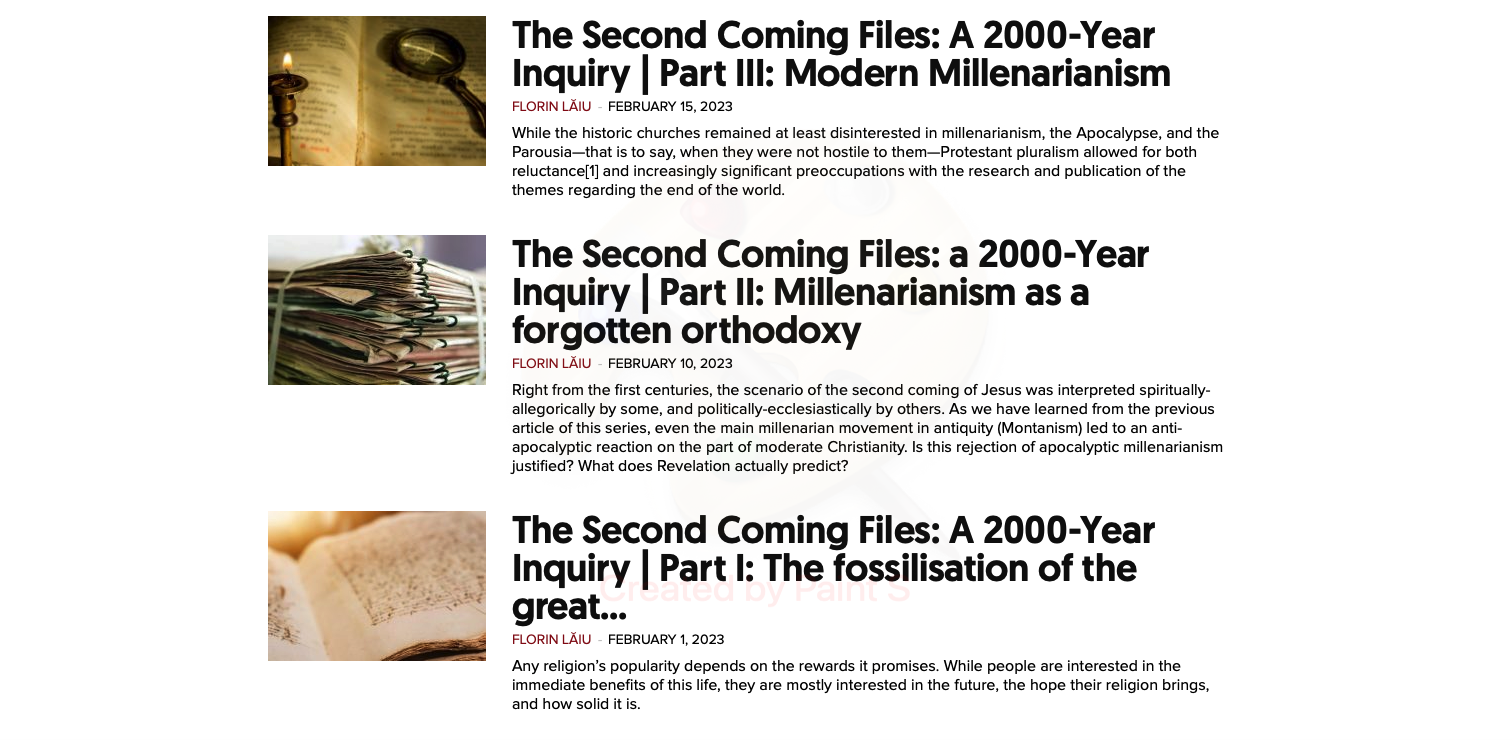After covering the historical evolution of the Christian teaching about the return of Jesus Christ in the first three articles, in the fourth article, which precedes the one that you’re reading now, I made a minimal review of some philosophical, political, religious, and esoteric currents that are important to understand the world in which the millenarian revivals of the 19th century emerged.
In this era of universal millenarian effervescence, unique in the history of Christianity, dozens of studies, articles, and books were published in the course of only a few decades, with an increasing frequency between the years of 1843-1847, from which people developed great expectations. Nineteenth-century millenarianism was in some cases brought about by earlier apocalyptic commentaries, such as the writings of the Chilean Jesuit Manuel de Lacunza and the polymath Isaac Newton but often also through independent study of the Bible.
Millenarian interest in England
Most interpreters of the Bible, especially in the British Empire, understood the “sanctuary”—which the biblical book of Daniel said must be cleansed—as the Holy Land or Jerusalem, which, incidentally, is still called El-Quds (the holy place, sanctuary) in Arabic.
Since Jerusalem was under Ottoman rule, what else could its cleansing mean, the commentators thought, than the liberation of Jerusalem and the entire country, which by the literal fulfilment of Paul’s prophecy about the return of the Jews (Romans 11), could inaugurate the awaited millennium? Such an upheaval was expected as the consequence of a war identified as the one in Revelation 16 (at Armageddon), which would clear the way for the second coming of Jesus to Jerusalem. This evangelical scenario was both “Zionist” and “Crusader.” The expected fall of the Ottoman Empire in the 1840s was identified, especially in the American Millenarian (Millerite) environment, as the fulfilment of the prophetic time of Revelation 9.
The fall of the Ottoman Empire, sought by the British in biblical prophecies
♦ In 1810, the British Anglican theologian John A. Brown claimed that the Holy Land would be freed from Turkish Islamic rule in 1844.
♦ In 1813, the Scottish landownder William Cuninghame predicted the war of Armageddon and the Judgment for the year of 1843.
♦ Between 1824 and 1848, the British evangelical rector Edward Bickersteth—secretary of the Church Missionary Society, theologian and jurist, a great man of action, who was concerned with encouraging missions, including among the Jewish—published many apocalyptic commentaries, largely influenced by Cuninghame. He was a firm premillennialist, but with dispensationalist tendencies, waiting (based on a double application of the 2300 years) for the resumption of the sacrificial system in 1843, with the complete restoration of the Jews in 1867. Theologian Thomas Birks, who became Bickersteth’s son-in-law in 1844 and professor of moral philosophy at Cambridge in 1863, began to assert premillennialism in 1843, thus engaging in various polemics.
♦ In 1827, Hebraist and pastor Thomas Keyworth, a Unitarian converted to Congregational Calvinism and a man with great love for the poor and for the promotion of the Christian mission, published a commentary that drew a parallel between the Revelation and the prophecies of Daniel, showing that Islam would be overthrown in 1843.
♦ In the same year, Baptist pastor Thomas P. White announced the return of Jesus and the liberation of the Holy Land for the year 1843.
♦ In 1829, Englishman P.H. Homan (Morning Watch) claimed 1843-1844 was the final term for the restoration of Israel, at the convergent end of three periods: the 7 times (2520 years) of Daniel 4, the 2300 days (years) of Daniel 8, and the 391 days (years) from Revelation 9.
♦ Additionally, in 1829, Congregationalist Edward Vaughan, a professor of history, announced the end of time for the year 1843, when the recovery of Jerusalem by the Jews, the Great Tribulation, the judgement of the “nations,” and the coming of Christ were expected.
♦ Alfred Addis, a graduate of Trinity College in Cambridge, announced “the cleansing of the ‘sanctuary’ and the triumph of Jewish independence,” as well as the cleansing of the Church for the years 1843-1844.
♦ Between 1829 and 1847, the Anglican cleric John Hooper published a series of writings about the second coming of Jesus and Armageddon in 1847, which was to inaugurate the beginning of the millennium and the cleansing of Jerusalem from pagan rule. He also marked the “cleansing of the Church” as the end of the period.
♦ Also in 1829, the Anglican minister William Pym, a worker of the British and Foreign Bible Society, published about the imminent coming of Christ and the millennial Jewish restoration in 1847 (later he changed this to 1843). His writing was one of the first published by the American Millerite magazine Signs of the Times, in 1840.
♦ In 1832, the anonymous “JGO” stated in the British magazine The Jewish Expositor and Friend of Israel, edited by Lewis Way, that the 2300 “days” of Daniel and the 390 “days” of Revelation 8 would end synchronously in the year 1844, when Islam would fall. In the same year, the Irish magazine The Christian Herald announced the end of the 2300 years and of Islam for the year 1843.
♦ In 1833, the Anglican clergyman Joshua Brooks, a prolific British publisher who had published prophetic studies by many of the above-mentioned authors in his journal (The Investigator) in 1831, made a review of millenarian theology from Origen until the 19th century, where he mentioned 1843 as the expected term, when the sanctuary of the Holy Land would be cleansed of Islam and returned to the Jews. The journal was open, and it published different opinions, including one that stated that it was not the Islamic enemy that was foreseen in the prophecy, but the Western antichrist, placed in the temple of the Church. Eight British Christian magazines specialised in the topic of millenarianism during this period.
♦ Between 1834 and 1845, the illustrious British architect and writer Matthew Habershon published seven prophetic commentaries and a book of premillennial hymns, in which he stated that the end of the 2300 years would be in 1843, with the breaking of the Islamic horn—the cleansing of the Jewish sanctuary of the Holy Land. Similar to other researchers of that period, who overapplied the “1 day = 1 year” formula, Habershon also synchronised the end of the 2520 days (“seven times” of Daniel 4) with the same expected prophetic term (1843/1844). Habershon also reckoned that the end of the 391 Ottoman “days” of Revelation 8 would be in 1844.
♦ In 1827, Edward Irving, a London Presbyterian minister, the most famous and original English preacher of that generation, published an English edition of Lacunza’s work. The interest aroused led to the famous interdenominational prophetic conferences at Albury Park (1826-1830). Unlike Lacunza, who had no knowledge of the 1 day = 1 year code as the key to apocalyptic chronology, Irving went with the historicist tradition, except that he predicted the end of “2400” years[1] for the year 1847, when he believed the restoration of Israel, the Parousia, and the beginning of the apocalyptic millennium would take place.
♦ British banker Henry Drummond, member of the Royal Society, parliamentarian, millenarian theologian, and sponsor of missionary Joseph Wolff, also belonged to the same circle. Together with Irving, Drummond is a founding apostle of the Apostolic (Irvingian) Catholic Church, the forerunner of later “charismatic” movements.
♦ The Albury Park prophetic conferences brought together a total of 44 personalities from different denominations over a period of four years. In addition to those already mentioned, during the first session, which lasted six days, there were present for intensive study and dialogue: Lord Mandeville, the missionary Daniel Wilson, Dodsworth, Marsh, Frere, Simons of Paul’s Cray, Haldane Stewart, William Cuninghame, C.S. Hawtrey, and Hugh M’Neile.
♦ After 1827, John N. Darby (father of modern dispensationalism) and Anthony Groves (missionary to Asia) borrowed Lacunza’s futuristic millenarianism from the Albury Park conferences. The publication Dialogues on Prophecy (1827) announced that the period would end in 1843 or 1847, which was also supported by the commentator “Anastius.”
♦ In 1830, the British magazine Morning Watch announced the end of the 2300 years for 1843 or 1847, and author William Anderson, a Scottish Presbyterian minister, published “An Apology for Millennial Doctrine.”
♦ In 1835, British millenarians Melville, Croly, M’Neile, and others formed the “Protestant Association,” promoting the message of the return of Jesus, as well as the anti-papist attitude. They published writings such as “Come Out of Babylon,” “Protestantism and Popery,” and others.
♦ In 1836, in his writing about the numbers in the book of Daniel, missionary Daniel Wilson, English bishop of Calcutta—a very active and vigilant pastor, despite his physical impediments—announced the completion of the 2300 years in 1847. The second coming of Jesus, the destruction of the Antichrist, the fall of Turkey, the conversion of the Jews and more would take place then, he believed.
A possible historical effect
The dominant and persistent theology of millenarianism in the 19th century that predicted the liberation and restitution of the Holy Land for the years 1843-1847, may have had some contribution to the promotion of the Zionist movement (1897) and the policy favourable to the repatriation of the Jews and the reconstitution of the State of Israel in the 20th century. Jewish romantic and political Zionism also emerged in the 19th century among Ashkenazi Judaism, largely as a result of the waves of anti-Semitism in Europe and the work of Theodor Herzl (1897) encouraging Jewish immigration to “Palestine,” which would become a national home for Zionist Jews in 1917.
Read the previous articles of this series:
The missionary of the return of Jesus
Beginning in 1822, “eccentric missionary” and British orientalist Joseph Wolff supported and preached throughout the world about the return of Christ in 1847.
Wolff’s biography and mission are downright fantastic, better than the most thrilling novel. Wolff was the son of a rabbi, a German Jew from Würtemberg. Curiosity about the Gospel had been planted in his mind at the age of seven, when an old man in the neighbourhood told him to read Isaiah 53. He attended the Protestant High School in Stuttgart. He converted after reading the books of the Catholic Bishop of Regensburg (Von Sailer), and in 1812, he was baptised by a Benedictine priest near Prague. He then studied in Tübingen and in Rome, at the Collegio di Propaganda, from where he was expelled because, after learning to think for himself, he criticised the doctrine of papal infallibility.
After spending a short period in a Redemptorist monastery in Switzerland, Wolff settled in London, where he joined the Anglican Church and continued his theological and orientalist university studies at Cambridge. Through Irving’s mediation, he married Lady Georgiana (1827), daughter of the Earl of Oxford. Between 1821 and 1828, his spectacular and difficult missionary journeys in search of “the lost ten tribes” covered various Ottoman provinces and territories outside the Empire: Egypt, Sinai, Jerusalem, Aleppo, Iraq, Iran, Georgia, Crimea, Anatolia, Armenia, Turkestan, Afghanistan, and India. Between 1836 and 1838 he travelled to Ethiopia and then to Yemen where he discovered Jews who believed they were from the tribe of Dan and descendants of the Rechabites. He reported that in Yemen he encountered Messianic expectations for the year 1840.
Wolff also travelled and lectured in America, where he was ordained as a deacon in New Jersey (1837), received the honorary degree of Doctor of Laws from Trinity College, Dublin, and in 1838 was ordained as an Anglican priest, receiving a rectory in Yorkshire. He died in 1862 (aged 67), while he was preparing for a new missionary journey. In England and in the rest of the world, his example, conferences, theology, and travel diaries greatly influenced the prophetic scenario of the conversion of the Jews, which is prevalent today among evangelicals and Messianic Jews.
The millennial concerns of the “father of the orphans”
After 1830, the great English philanthropist of Prussian origin, George Müller, the “father of the orphans” of Bristol, became a devout millenarian after he arrived in England.
As a young man, Müller had been quite far from being a saint; on the contrary, he had been addicted to gambling, a liar, and a thief. At the age of 10, he stole money from his father, who was a preceptor, and at the age of 14, while his mother was dying, he was having fun playing cards and drinking with friends. His father, however, provided him with a religious and theological education at the Pietist University of Halle. There, young George was invited to participate in a prayer group, where he was well received and began to study the Bible and have Christian discussions with others.
At one of those meetings, he was deeply impressed by a man who was praying on his knees, and was convinced of his need for salvation, true repentance, and forgiveness. He began to pray to God for his past and future and gave up drinking and other vices, hoping to become a missionary. In a short time, Müller offered himself to the Continental Society, initiated by Robert Haldane (Geneva) and Henry Drummond (London), for the evangelisation of Europe, showing himself willing to serve in Bucherest, Romania. However, for unknown reasons, this project was not realised.
In 1828, Müller offered himself to the British society promoting the evangelisation of the Jews, but arriving in London in 1829, he fell seriously ill, and almost died. In the hospital, he met Henry Craik, a millenarian from the Plymouth Brethren, who remained his friend for life, as they were both men of prayer. After regaining his health, Müller gave up his intention to become a missionary and let himself be guided by God through prayer.
Converted to millenarianism by Craik and impressed by the beauty in the hope of Jesus’ imminent return, Müller joined the Plymouth Brethren and married the sister of Anthony Groves.
The question that troubled Müller since he received the message of Jesus’ return was the one raised by the parable of the bags of gold: “What could I do for the Lord, before His return, that He may come soon?” Influenced by the biography of the great German pietist, philanthropist and educator August H. Francke, who had founded the University of Halle, Müller began his life’s mission. In 1834, he founded an institution for the promotion of the Scriptures at home and abroad, to help Christian education and missionaries.
In 1835, he founded two schools for boys and three schools for girls, without government support, only accepting unsolicited donations. He always acted according to the principle of service without salary and turned only to God. During his entire career, he administered sums amounting to well over a million pounds, equivalent to 90 million pounds today. He made about 15 missionary trips to Europe, America, Asia, and Australia, in an age when there were no planes.
He distributed hundreds of thousands of copies of the Bible, almost three million New Testaments and almost 250,000 religious writings, translated into twenty languages. He founded 117 Christian schools, where more than 120,000 poor children were educated, and founded and managed five orphanages which housed a total of 2,000 orphans.
Instead of conclusions
Thus, in England and in the colonies, clergy and laity, men and women, old and young, and intellectuals of various Christian orientations contributed, each with their specific gifts and partial understanding, to the unprecedented progress of announcing the coming of Jesus in the first half of the 19th century. This unique moment of Christianity is important and admirable in itself, but also because it created a series of free religious communities, in which millenarianism was perpetuated in specific forms and in which the joyous hope of Parousia still lives.
Florin Lăiu is a former Bible professor at the Theological Seminary of the Adventus University in Romania where he worked for 28 years, specialising in biblical languages, biblical exegesis, apocalyptic and biblical translation. Now retired, he is an Adventist apologetic, poetry and music enthusiast, author of articles and books, husband, father of four, and grandfather of six.




















